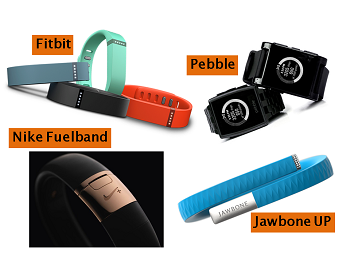 PATTY MURPHY
PATTY MURPHY
HNI Health Systems Consultant
Could wearable health technology be any hotter? Everywhere you look, the person next to you has a Fitbit around her wrist, monitoring everything from calories to hours slept to steps taken in a day.
As we move toward the holidays (we're only 41 days until Christmas!), with all those rich desserts, frantic shopping, and festive fetes, now seems like a great time to focus on health and weight management. Wearable technology could be leveraged to stay on track.
But why should employers care about this new tech trend? Well, there's evidence that wearable technology improves employee productivity. What's more, integrating wearable tech with your wellness program gives your talent even more tools for improving their own health. And when employees improve their well-being, their employers spend less on health care coverage.
Wearable tech is a hot topic, and HR pros need to hit some high points to get a feel for the issue. Following is a mini wearable technology guide for HR with five things to think about when it comes to the gadgets:
1.) If you're thinking about leveraging wearable technology, you're not alone
Some employers have started integrating these techy bracelets with their employee health benefits programs. For instance, activity tracked by HNI employees with a Fitbit or Pebble syncs to our online wellness portal. This exercise earns points, which convert into a financial reward. Other wearable proponents include software design firm Autodesk, who bought Fitbit trackers in bulk to sell to their staff at a discount, and oil giant BP, who gave employees the option to wear a free Fitbit Zip in exchange for tracking annual steps. BP employees who stomp out 1 million steps get lower insurance premiums.
2.) Before you jump in, take it to your people
Get a poll going around the office to find out how important wearables are for your talent. Ask if they'd consider buying a wearable to monitor progress toward a health goal if the company subsidized the purchase. There is a chance that no one will bite, but you could be surprised by how many people are looking for a good deal or need a little push to get going.
3.) Create some hype by making wearable technology a prize
If your employees aren’t already taking advantage of wearable health technology (and you want to prime your culture for a future with wearables), try building interest by including a device as a wellness program prize. For example, if your program aims to increase employees' physical activity, offer up a Jawbone UP or Nike FuelBand as a prize for the top mover.
4.) When it comes to data from wearable technology, remember KISS (Keep It Syncable, Stupid!)
Explore how data collected by an employee's wearable device would be transferred to your system (assuming tracked activity is part of wellness program participation). Employees don't want to be tied to their desktop PCs when it comes to tracking health progress. They want activity to sync automatically. Also, you want to keep it HIPAA compliant, no PHI.
5.) Beyond improved health, wearable technology has other benefits
Hot millennial talent has embraced technology in all aspects of their lives. They want to work for an employer that's also in love with 21st century gadgets and apps. Employer wellness programs that include wearable technology (which millennials likely already are using) are more attractive to young job seekers and could be the difference between accepting your offer and moving on to your competitor.
Wearable technology is a rapidly developing field, and the health data these devices are collecting can help the people who sport them fend off lifestyle-related diseases, such as heart disease and diabetes. Employers have a huge interest in reducing the expensive effects of those types of illnesses, and wearable tech could be the key for both HR and workers.
Have you integrated wearable technology into your benefits programs? What have been your results so far? What other elements would you add to our wearable technology guide for HR? Please share in comments!
Related Posts:
20 Facts HR Needs to Understand About Working with Millennials
7 Clues You're Ready for New HR Technology
Decoding Reasonable Alternative Standards for Wellness Programs
.png?width=69&height=53&name=Acrisure%20Logo%20(White%20Horizontal).png)

 PATTY MURPHY
PATTY MURPHY![[ Slide Deck & Webinar Recording ] BENEFITS COMMUNICATION BOOTCAMP: How to Engage & Inspire Your Employees This Year at Open Enrollment -Click here if you've struggled to get employees to understand and appreciate your benefits offering-](https://no-cache.hubspot.com/cta/default/38664/ad87fd1e-4295-4621-aed6-fbb12540e95d.png)
